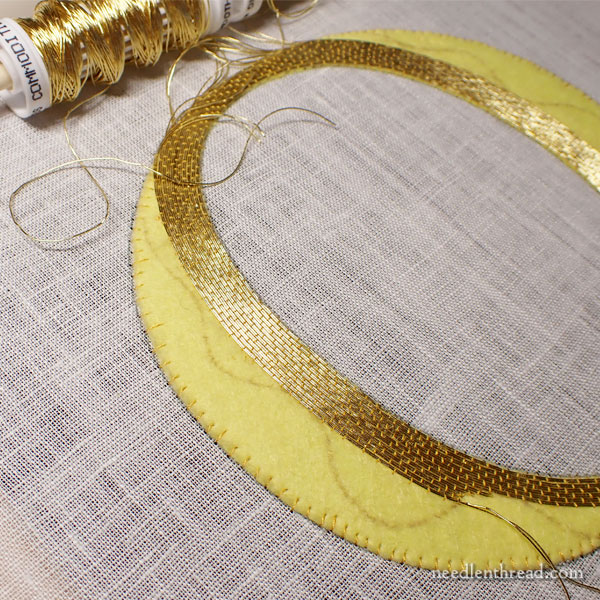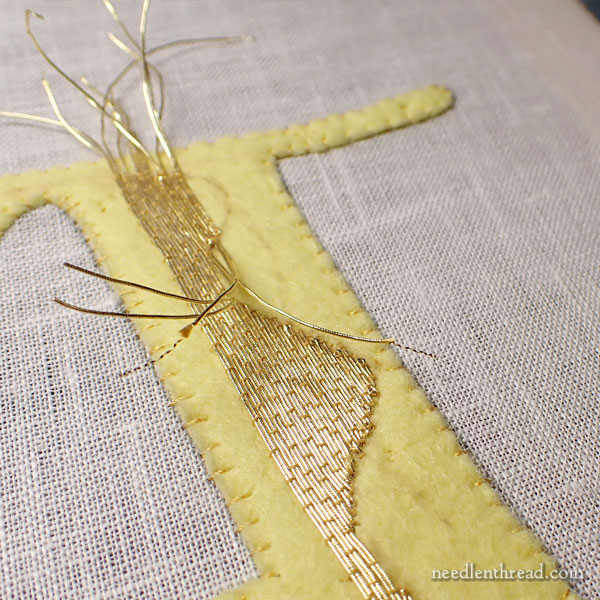In the studio, we’ve been gearing up for a very big project. It involves design, lots of goldwork embroidery (and other embroidery)… and did I mention it is Big?
We’ll be making altar covers for a new church here in Kansas. The altar covers – also known as vesperale or “vesperal cloth” – are essentially dust covers that go on top of an altar in a church any time the altar is not in use, in order to protect the linens underneath it and to keep them free of dust.
The vesperale is sometimes plain, but it can also be embellished, and, in many churches, it is typical to see lettering of some sort across the front fall (the front of the cloth falling over the edge of the mensa or “table” top of the altar). The typical lettering is usually “Holy, Holy, Holy” or “Sanctus, Sanctus, Sanctus” or something similar.

The vesperale (pronounced “ves-per-all-ay”) can be made out of practically any material that is suitable for the furnishings of a church. Often, they’re made of wool felt, but they can also be made from more elegant materials. Sometimes, they’re made from a colored linen. Sometimes, they’re made from silk, or velvet, or brocade, and so forth.
The vesperale can be any color, technically. Often, it’s green, and I suppose that’s because green is the most widely used liturgical color, but it doesn’t have to be green. The color of the cloth can be chosen to match the interior of the church, or to match the artwork, stone, or marble of a particular altar.
There can be text on the front fall of the vesperale, or there can be a symbol in the center of the front fall. Or there can be both. The front fall could be embroidered or trimmed out, without text or symbols. Or it can be plain.
If there is a text, the text can say anything suitable for use in the church – usually a devotional phrase that reminds the faithful of the whole purpose of the altar or sanctuary of the church. The word or phrase might be particularly chosen for a particular altar in a particular church, as part of a theme. So there’s lots of leeway in choosing how to adorn (or if to adorn, or how much to adorn) the vesperale.
The vesperale we are working on (there are actually several) is adorned. The main altar cover is our first project, and it will be adorned with lettering and a symbol. There’s a possibility of also incorporating some decorative embroidery to coordinate with the artwork inside the church, but that has not been determined or affirmed yet.
Right now, we are testing, because you can’t really launch into a project like this without some kind of testing. First, there’s the testing of designs, layout, colors, lettering styles, all of that. Then, as you start to hone the ideas and get feedback from other people involved in the interior plans of the church (or whatever building you’re making something for), you start testing materials in order to understand many things:
Are the materials suitable for executing the ideas? How will they look in the space, with the other art or furnishings around them? How will they hold up? How available are they? How efficiently can they be worked with? Do they fit budget constraints?…. There are all kinds of questions to consider.

There is much collecting and gathering that goes on before a project like this is “officially underway” – as in, the actual project itself is in the works – but now that we are in a materials-testing phase, I see the project as official. We have our lettering designed. I’m working on the decoration that goes with the lettering. And now it’s material testing time.
We picked two letters from the phrase (an A and an O) and Anna and I are each working one. On these tests, we’ll probably incorporate some seemingly-crazy mixes of materials and techniques, just to get an idea of how, what, and why we will eventually use what we will use. Hopefully, though, the ideas that we have already sketched out will actually end up being Just Right, and we won’t have to spend too much time in the testing phase of things.
I still have to overcome the materials availability issue. Here in the States, the availability of goldwork supplies seems to be diminishing again. We enjoyed a pretty good surge of availability for a while – I would say some ten years or more – but now I feel like I’m back in the 1990’s-2000’s, when goldwork supplies were really hard to find. Distributors apparently aren’t stocking them and retailers tell me they don’t carry them anymore – or at least, not a variety. Things can be special ordered but “it will take months” and “they would have to be made” and so forth. And yet… and yet… goldwork supplies are still out there! I will likely branch abroad to bring them in. And that’s fine.
So, that’s a project that’s underway here in the studio, and as we make progress on it, I’ll keep you informed! I’ll show you our successes and failures, troubleshoot things with you, explain my thoughts as we make decisions, talk about time management, and so forth. I’m excited about this project, and super excited that it is finally underway.
Coming Up
Wednesday, we’ll be back at Cotton Quartet, with the next installment!
I’m restocking books of all sorts. It’s a sloooooow process. Sorry! I will have more books in the shop this week, for those who are patiently waiting!
We’ve got the next Stitch Snippet underway – it’s truly a snippet. Small, but mighty!
We have a small number of Bee-Jeweled Pincushion kits available.
And this week, we’re also doing some studio rearranging to make more Space. I’ll share that process with you, I’m sure!
Happy Monday!







Have you thought of getting in touch with Goldwork designer Jessica Grimm? If anyone knows about the availability of goldwork supplies in Europe, I think she would.
Thanks, Alicia, Yes, I have corresponded with Jessica quite a few times!
Oooh! I’m so looking forward to following this process. Your ecclesiastical work has always been a favorite.
Thanks, Cindy! 🙂
Hooray! I confess your ecclesiastical work is my favorite. I am also working on a new vesperale. So I am watching with great interest. I’m still planning, though. Congratulations on getting to the actual working stage!
I am so glad for this series on gold work. My daughter will be graduating seminary a year from now and I am just starting on some things for her because the expense is so high. My first project is a green stole with a gold tree of life at the bottom of both sides. A friend will also be helping me. I hang on your every word so that I can do my best work. No pressure there! Thank you so much.
Hello, Mary
I’m not sure if it’s any help to you but I do have a list of suppliers for goldwork, here on the other side of the pond. I don’t have it to hand but the Golden Hinde comes to mind straight away.
Yes! One of the best, most thorough suppliers out there!
Dear Mary
How exciting for you to be making Alter cloths or vesperale cloths for a new Church. It’s so nice to hear of a New Church as opposed to closing them, as is the fashion for a lot of Churches in the UK. I’m really surprised that there is a shortage of gold supplies for embroidery it’s such a shame, I do hope you find somewhere to purchase the gold, it looks like you will need a lot of gold supplies for the project. I really looking forward to the progress on this project I’m sure it will be really interesting. Thank you for sharing with us your new vesperale cloth project and for the photos, look forward to the progress on this.
Regards Anita Simmance
The testing aspect of this is really interesting to me. How do you decide how much to commit to the testing phase? I’m assuming that the work and supplies you use in this phase are not part of any final product. Do you file this work for future reference or does it eventually become rubbish?
I commit as much time and materials necessary to the testing phase to be certain about the techniques and materials I want to use.
I will keep it – it’s a good learning tool.
Looks beautiful How difficult is it to work with the gold thread?
Not really difficult at all. Most goldwork is done with only two techniques: couching and sewing on like a bead. So the stitching itself is not difficult. The foundations that you build under the stitching, if you’re wanting some dimension and so forth, require some familiarity, but none of it is “hard” to do. Probably the trickiest part is chip work, when you need to cut precise sizes. But other than that, it’s pretty much easy. It takes time, it can be a little monotonous if you’re doing something large or working a repeat design, but it’s the kind of work you get into a “flow” with, and it becomes a bit mesmerizing.
Dear Mary, when lookimg for tips about caring for church linens, I came across this website. Perhaps they can provide you with some of the materials you need. https://altarlinens.com/church-linens-expert-about/
Mary, these are all extraordinarily beautiful! And you always make everything look so easy to do it perfectly…